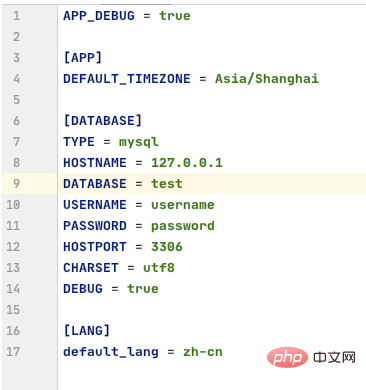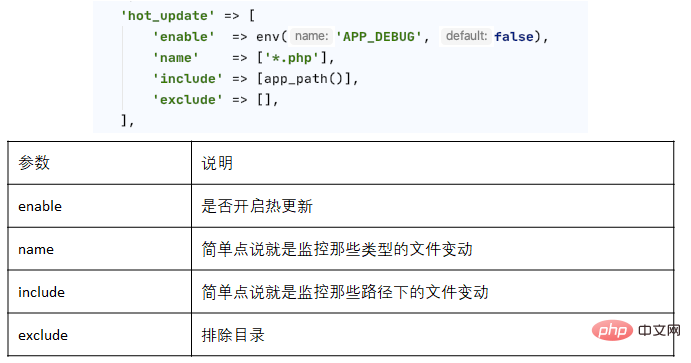Think-Swoole tutorial hot update
I recently started to contact and develop Swoole. When I first came into contact with it, I was really confused and I searched for a lot of information to understand it. Recently, I have been working on some advanced functions of Swoole. I have summarized some experience of integrating Swoole with the Thinkphp6.0 framework based on actual projects, and compiled and shared it with some information on the Internet.
Recommended tutorials: "thinkphp" "swoole tutorial"
Since the PHP file is resident in the memory during the running of the Swoole service, so It can avoid repeatedly reading the disk and repeatedly interpreting and compiling PHP in order to achieve the highest performance. Therefore, after changing the business code, you must manually reload or restart it to take effect.
The think-swoole extension provides a hot update function. It will automatically reload after detecting that the files in the relevant directories have been updated. This eliminates the need for manual reload operations and facilitates development and debugging.
If your application has debug mode enabled, hot update is enabled by default. In principle, it is not recommended to turn on file monitoring in deployment mode. On the one hand, there will be performance losses, and on the other hand, any modifications made to the files need to be confirmed before update deployment can be carried out.
ThinkPHP 6 has a .example.env file by default in the root directory of the application. Copy this file and rename it to .env. When this special .env environment variable file is defined and APP_DEBUG = true is set in it, hot update will be enabled by default. In addition, you can also directly set enable in the hot_update configuration in /app/config/swoole.php to true.
.env

config/swoole.php

The above is the detailed content of Think-Swoole tutorial hot update. For more information, please follow other related articles on the PHP Chinese website!

Hot AI Tools

Undresser.AI Undress
AI-powered app for creating realistic nude photos

AI Clothes Remover
Online AI tool for removing clothes from photos.

Undress AI Tool
Undress images for free

Clothoff.io
AI clothes remover

Video Face Swap
Swap faces in any video effortlessly with our completely free AI face swap tool!

Hot Article

Hot Tools

Notepad++7.3.1
Easy-to-use and free code editor

SublimeText3 Chinese version
Chinese version, very easy to use

Zend Studio 13.0.1
Powerful PHP integrated development environment

Dreamweaver CS6
Visual web development tools

SublimeText3 Mac version
God-level code editing software (SublimeText3)

Hot Topics
 Performance optimization and debugging of TP6 Think-Swoole RPC service
Oct 12, 2023 am 11:16 AM
Performance optimization and debugging of TP6 Think-Swoole RPC service
Oct 12, 2023 am 11:16 AM
Performance optimization and debugging of TP6Think-SwooleRPC service 1. Introduction With the rapid development of the Internet, distributed computing has become an indispensable part of modern software development. In distributed computing, RPC (RemoteProcedureCall, Remote Procedure Call) is a commonly used communication mechanism through which method calls across the network can be implemented. Think-Swoole, as a high-performance PHP framework, can support RPC services well. but
 High scalability and distributed deployment of TP6 Think-Swoole RPC service
Oct 12, 2023 am 11:07 AM
High scalability and distributed deployment of TP6 Think-Swoole RPC service
Oct 12, 2023 am 11:07 AM
TP6 (ThinkPHP6) is an open source framework based on PHP, which has the characteristics of high scalability and distributed deployment. This article will introduce how to use TP6 with Swoole extension to build a highly scalable RPC service, and give specific code examples. First, we need to install TP6 and Swoole extensions. Execute the following command in the command line: composerrequiretopthink/thinkpeclinstallswo
 Data encryption and identity authentication mechanism of TP6 Think-Swoole RPC service
Oct 12, 2023 am 11:29 AM
Data encryption and identity authentication mechanism of TP6 Think-Swoole RPC service
Oct 12, 2023 am 11:29 AM
Data encryption and identity authentication mechanism of TP6Think-SwooleRPC service With the rapid development of the Internet, more and more applications need to make remote calls to realize data interaction and function calls between different modules. In this context, RPC (RemoteProcedureCall) has become an important communication method. The TP6Think-Swoole framework can implement high-performance RPC services. This article will introduce how to use data encryption and identity authentication.
 Highly concurrent request processing and scheduling of TP6 Think-Swoole RPC service
Oct 12, 2023 pm 12:33 PM
Highly concurrent request processing and scheduling of TP6 Think-Swoole RPC service
Oct 12, 2023 pm 12:33 PM
Highly concurrent request processing and scheduling of TP6Think-SwooleRPC service With the continuous development of Internet technology, concurrent request processing and scheduling of network applications has become an important challenge. In the TP6 framework, the Think-Swoole extension can be used to implement high-concurrency request processing and scheduling of the RPC (RemoteProcedureCall) service. This article will introduce how to build a Think-Swoole-based RPC service in the TP6 framework and provide
 TP6 Think-Swoole's RPC service and message queue integration and application
Oct 12, 2023 am 11:37 AM
TP6 Think-Swoole's RPC service and message queue integration and application
Oct 12, 2023 am 11:37 AM
Integration and application of TP6Think-Swoole's RPC service and message queue In modern software development, RPC service (RemoteProcedureCall) and message queue are common technical means used to implement service calls and asynchronous message processing in distributed systems. Integrating Think-Swoole components in the TP6 framework can easily implement the functions of RPC services and message queues, and provides concise code examples for developers to understand and apply. 1. RPC
 Security protection and authorization verification of TP6 Think-Swoole RPC service
Oct 12, 2023 pm 01:15 PM
Security protection and authorization verification of TP6 Think-Swoole RPC service
Oct 12, 2023 pm 01:15 PM
Security protection and authorization verification of TP6Think-SwooleRPC service With the rise of cloud computing and microservices, remote procedure call (RPC) has become an essential part of developers' daily work. When developing RPC services, security protection and authorization verification are very important to ensure that only legitimate requests can access and call the service. This article will introduce how to implement security protection and authorization verification of RPC services in the TP6Think-Swoole framework. 1. Basic concepts of RPC services
 TP6 RPC service and microservice architecture practice cases built by Think-Swoole
Oct 12, 2023 pm 12:04 PM
TP6 RPC service and microservice architecture practice cases built by Think-Swoole
Oct 12, 2023 pm 12:04 PM
Introduction to the practical case of RPC service and microservice architecture built by TP6Think-Swoole: With the rapid development of the Internet and the expansion of business scale, the traditional monolithic architecture can no longer meet the needs of large-scale business scenarios. Therefore, the microservice architecture came into being. In the microservice architecture, the RPC (RemoteProcedureCall) service is an important way to achieve communication between services. Through RPC services, various microservices can call each other conveniently and efficiently. In this article
 Performance testing and performance tuning of TP6 Think-Swoole RPC service
Oct 12, 2023 pm 02:19 PM
Performance testing and performance tuning of TP6 Think-Swoole RPC service
Oct 12, 2023 pm 02:19 PM
Performance testing and performance tuning of TP6Think-SwooleRPC service 1. Introduction With the rapid development of the Internet, the application of distributed systems is becoming more and more widespread. In distributed systems, RPC (Remote Procedure Call) is a common communication mechanism, which allows services on different nodes to call each other and achieve collaborative work in distributed systems. In the TP6 framework, Think-Swoole, as a high-performance Swoole driver, provides convenient RPC service support. This article mainly introduces T






